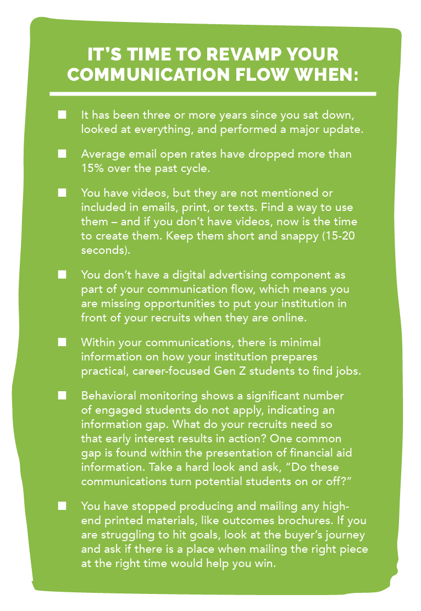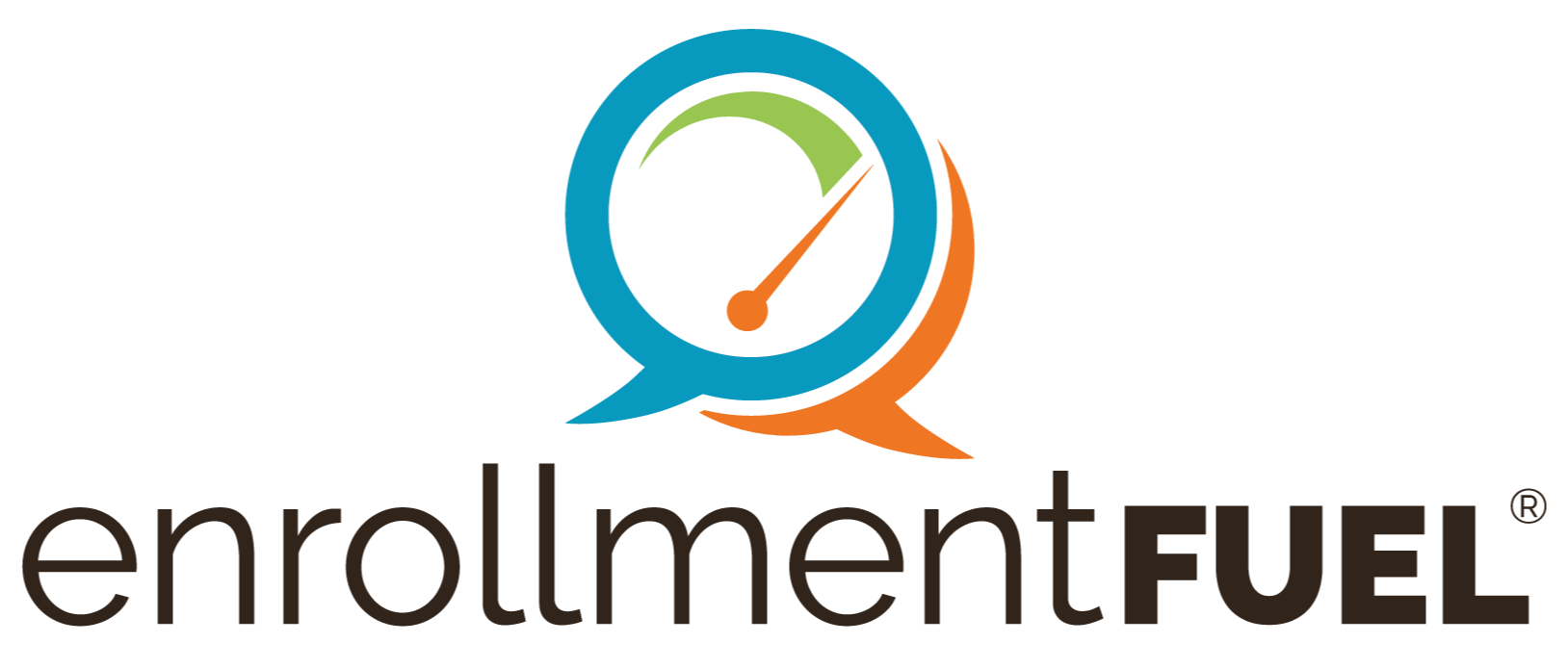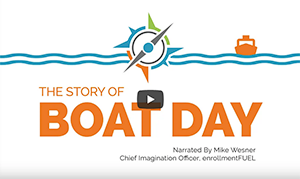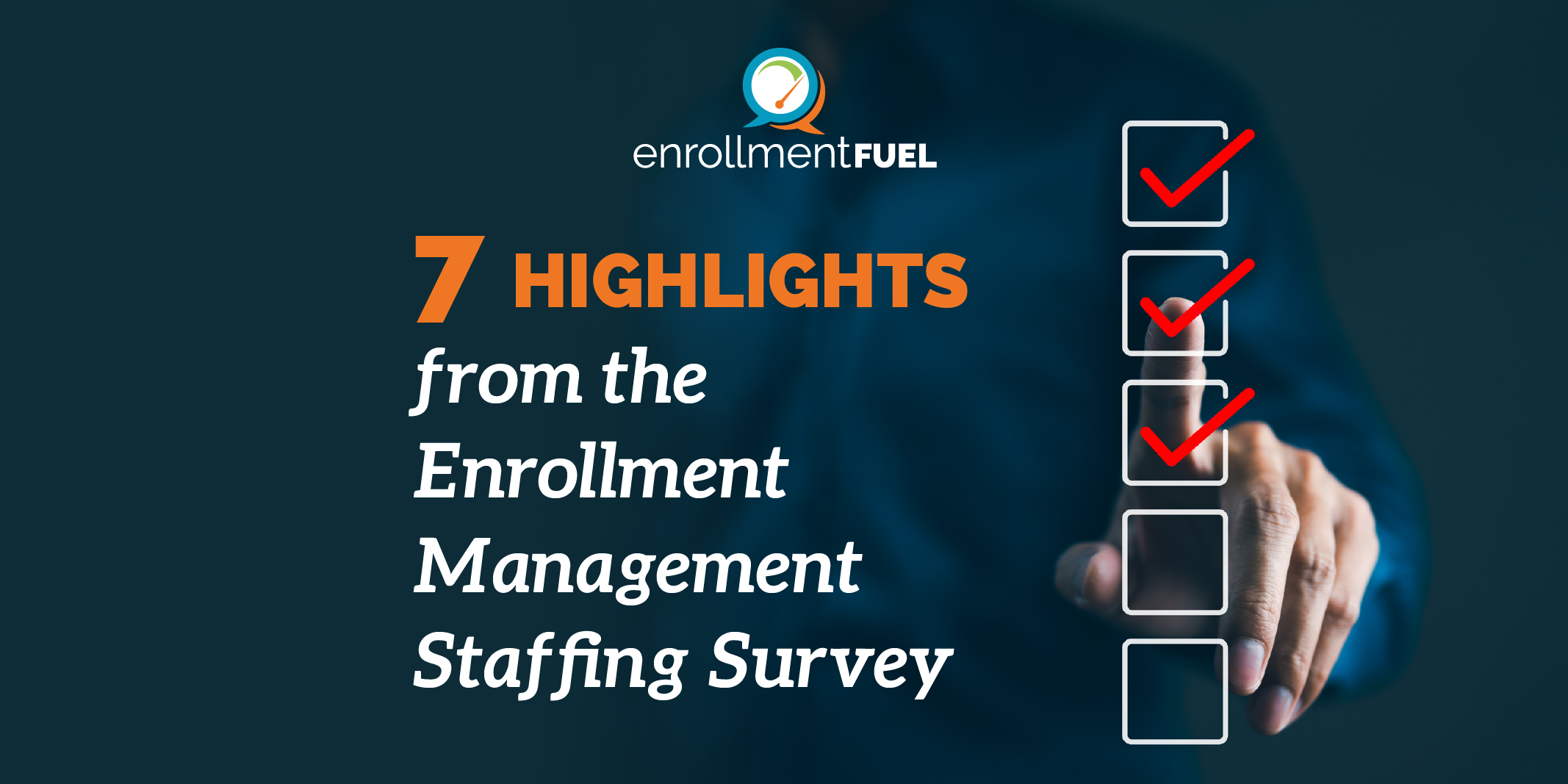7 min read
The Evolution of communication flows: a 360° Journey
Recently, I traveled to visit clients and stopped on my way back home to visit with a former colleague from a previous institution. Over dinner, we reminisced about the good old days when things were tough, but not nearly impossible. And while neither of us really wanted to think about COVID (aren’t we all over this by now?), we did talk about the impact on enrollment and what the future of admission will look like as we get closer and closer to the demographic cliff that lies ahead.
These conversations got me thinking about my own college search process. You may be surprised to know that I still have the main recruiting packet my alma mater sent me back in 1988! Check out the picture to the left, and you will see that Mary Baldwin sent me a box instead of an envelope, which I loved. Inside, the pieces were menu choices of all the things I could consider in college. Even years later, I remember how exciting it was to get this box. I felt like I had endless choices, and they were mine to make. The box made my choice of a college feel less like a decision that had to be made and instead turned it into a meaningful ritual marking a rite of passage to true adulthood.
Yes, those were the days when communication flows were comprised of snail mail. There wasn’t email, digital advertising, social media, or texting. It was mail and phone. And I loved coming home and knowing that for the first time in my life, I had mail that was really my own (other than a card from the grandparents around holidays and birthdays). It made me feel grown-up. It was my information to pour over or toss.
Like students today, I fast-pitched lots of the material schools sent to me. My keep-or-trash criteria was simple. If the material was different, intriguing, or engaging in some way, I kept it, regardless of my immediate interest in the school. That was because I was inquisitive enough to pause and interact with the materials from the schools that marketed using Hallmark’s principle, “When you care enough to send the very best.”
Fast forward to 2021, and guess what? Thirty years later, in a focus group with students, they said the same thing. I heard comments like, “Every school sends a postcard, so they all start to look alike. They are boring. And, they never really say anything that matters. Most go into
the trash.”
I listened, made a note, and then asked, “What DO you pay attention to, then?”
A young woman with a long red braid said, “I know it costs more money, but anything that stands out. I really like it when things don’t look too polished. I know it’s just marketing. I hate the pictures that look fake. Why don’t schools realize our generation relates to raw, authentic photos like selfies and students just being themselves and natural?”
A young man who had been texting on his phone looked up finally and said, “I really like it when I get something that I can engage with—a different shape, something interactive, and unusual.”
Another student chimed in. “Honestly, how is anyone supposed to be able to decipher anything when nothing stands out?” She took out her cell phone and showed me a picture of all the direct mail she has received.
After we all took a look, she said, “And one last thing I would say is this: ‘Stop sending me emails!’ Unless I have applied, I don’t care. I had to give up my personal email and open another account just to get away from all the nonsense schools send to me.”
These student reflections clearly illuminate that contemporary communication flows are much more diverse (omnichannel) than the few phone calls I received from my admission counselor (Jane Kornegay—I still remember her name) and my snail mail. Today, colleges and universities must use an integrated approach with multiple media choices to crack open doors and get a foot inside. Competition is already stiff. When we reach the demographic cliff in a few years, expect the market to become even more competitive as regional universities open up their admission criteria to meet their numbers.
So, as the market evolves, what do you do to get noticed now?
First, the communication flow isn’t a one-and-done task. Much like the website (let me give Aaron Porter at Carson-Newman a shout-out for this observation), it requires constant attention to be updated, refreshed, modernized, and aligned with what students and parents are hungry to know. Sadly, when I consult with most schools, they tell me they don’t have the bandwidth or resources to stay on top of their website, let alone the communication flow.
Typically, a calendar of events is made, and the same basic calendar is used year-after-year because emails have been written and mailings have been designed. Emails and mailings get a quick scan to see if any information needs updating, but busy enrollment professionals may not stop and evaluate whether there is a better approach. Someone on the team sets up campaigns in the CRM, and materials go out on a rote schedule. Some schools segment messaging for their audience, but when I survey the market, I find segmentation strategies to be minimal, overall.
Repurposing materials year-after-year is widely practiced because it is seen as a cost-savings tactic. Let me pause here to say there is a big difference between tactics and strategies. Communication flows should be strategic.
An Innovative Thought on Strategic Communication Flow
I have a question for you. What is the number one function of the enrollment office? If you said sales, I would high-five you (well, maybe elbow bump, instead). Yes, sales (especially at small private colleges—but more and more at the nifty fifty and even public universities) is truly the number one function of the admission office. If we embrace this concept, many of us would want to consider revamping our communication flow to match the buyer’s journey.

I am a huge advocate of adopting a communication flow to align with the buyer’s journey both in terms of the “architecture” of the flow and also to fit the student/family experience. The theory is sound, and it works. But, it isn’t for the faint of heart—it takes grit, tenacity, and resources.
In this scenario, the design of the commu
 nication flow allows for segmentation on multiple levels. Yes, you can still segment on major, affinity group, or any variety of other known aspects, but the focus in this design is an intentional alignment with the student’s psychology. As admission counselors work the stages of their funnel, they would identify where the student is on the continuum, denote it as a field in the CRM, triggering a set of communications designed to market, support, or track. These communications would be more than just direct mail and email. They would include texting, personalized mailings from the counselor, and digital ads with calls to action that vary depending on timing within the admission cycle. What do I mean by this? I mean that in April, the student will likely be moving into the commit stage of the cycle, so the school would be messaging about their promise to fulfill the comprehensive education (whole-person development) that the student and family are purchasing.
nication flow allows for segmentation on multiple levels. Yes, you can still segment on major, affinity group, or any variety of other known aspects, but the focus in this design is an intentional alignment with the student’s psychology. As admission counselors work the stages of their funnel, they would identify where the student is on the continuum, denote it as a field in the CRM, triggering a set of communications designed to market, support, or track. These communications would be more than just direct mail and email. They would include texting, personalized mailings from the counselor, and digital ads with calls to action that vary depending on timing within the admission cycle. What do I mean by this? I mean that in April, the student will likely be moving into the commit stage of the cycle, so the school would be messaging about their promise to fulfill the comprehensive education (whole-person development) that the student and family are purchasing.At enrollmentFUEL, our team is always looking beyond higher education to gain insight from the larger marketing world. One of the items recently shared was the “State of the Connected Customer” report from Salesforce Research. They found, “68% of customers say they are online more often than not.”2 This indicates digital advertising should be an integral part of your communication flow because a well-placed ad that is contextually in sync with your “buyer’s” journey could be the nudge a recruit needs to take the next step.
The best Student Search communication flows use brand storytelling, where every email brings fresh insight to enrich a student’s understanding of your institution’s value. No matter what the channel, communications should spark curiosity and the desire to know more. In a study titled, “Circumventing resistance to novel information: Piquing curiosity through strategic information revelation,” published in the Journal of Experimental Social Psychology, researchers found revealing new information invoking curiosity can substantially impact initial judgments.3 Curiosity creates a knowledge gap, motivating students and parents to investigate and learn more, leading to a re-evaluation of an earlier perception. To put it in practical terms, by invoking curiosity, you can motivate students to reach out and ask for detailed information on topics like financial aid, internship possibilities, or how to double major and still graduate in four years. If you are doing a great job selling your value proposition, students may ask deeper questions relating to their college experience, how their lives will be impacted, and what new knowledge they will gain to successfully prepare them for the job market.
Direct mail is an effective way to give any campaign a lift. Though students dismiss the efficacy of the “lowly” postcard, enrollmentFUEL has accumulated plenty of evidence proving this basic form of communication gives more than 90% of campaigns a lift in email open rates. However, higher education has not paused as an industry to assess the merits of this form of communication in the current landscape. All mail is seeing a much higher interaction. True, email is more economical and has value, but I caution schools to recognize it isn’t the one-size-fits-all solution for a successful communication flow. Institutions need to take the stand to appropriately budget for direct mail, as well as texting and digital advertising.
The real magic of direct mail happens when used deeper in the funnel to share information with engaged leads. If you have limitations within your budget, don’t discount mail, altogether. Instead, ask, “Who is opening my emails? Communicating with admission counselors? Visiting my website? Signed up for a (virtual) tour?” Look at your data, and determine how you can intentionally send mail to a smaller cohort of the right students with a focused message at the right time. This will save you money while still recognizing the actual value of direct mail in moving students through the later stages of the buyer’s journey.
Last Thoughts
Maybe your prospective students won’t hoard their recruitment material 30 years after the fact, but surely you can hope for your material to elicit the emotion required to move them to the next stage of the funnel. Looking at your communication flow from a strategic lens rather than a tactical lens is the first step to success. And being intentional about updating the content, pictures, and delivery mode is critically important. If you haven’t taken time to modernize your flow, or built it to align with your buyer’s journey, this summer is a great time to dig in and revolutionize your process.
Download Article
Related Articles
Emailing Unengaged: Adapting to Succeed Today and Tomorrow
Enrollment managers have been trained to squeeze everything they can out of their prospective...
Can Look-Alike Modeling Replace Traditional List Purchasing?
As the enrollmentFUEL team talks to enrollment vice presidents around the country, one topic comes...
Madison Square Garden, Here We Come: Recruiting Adult & Graduate Students
When it comes to graduate and adult recruitment, there are many moving parts. Unlike the...





Leave A Comment